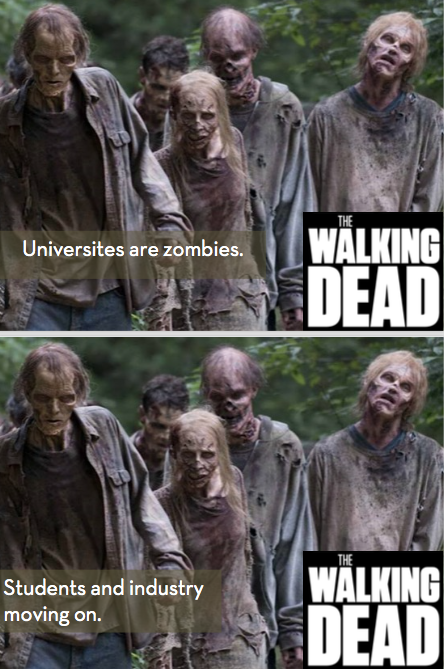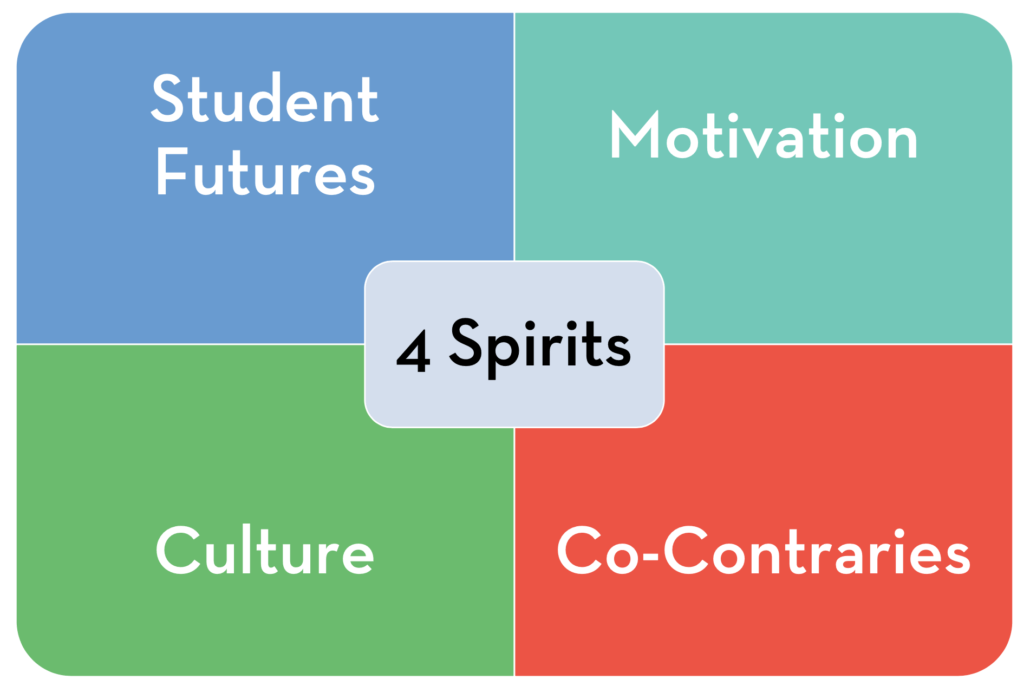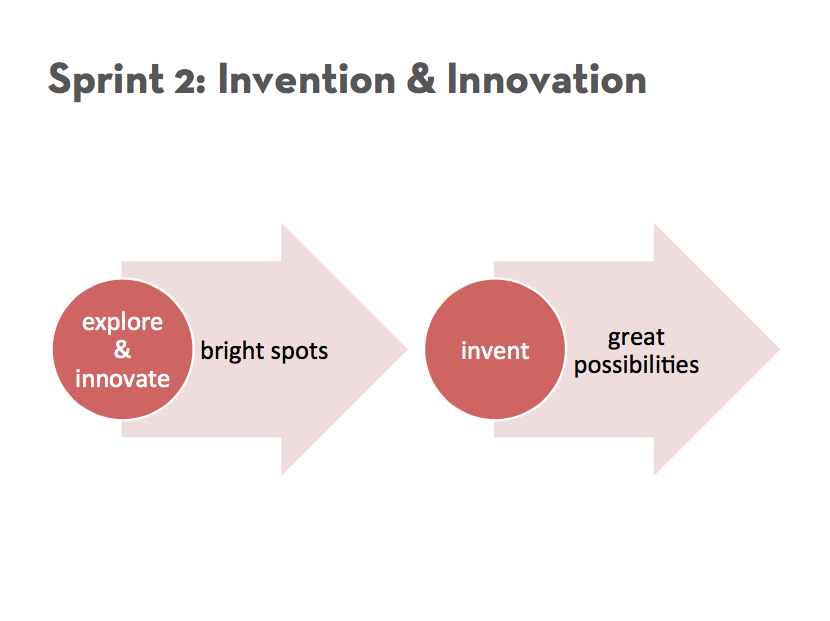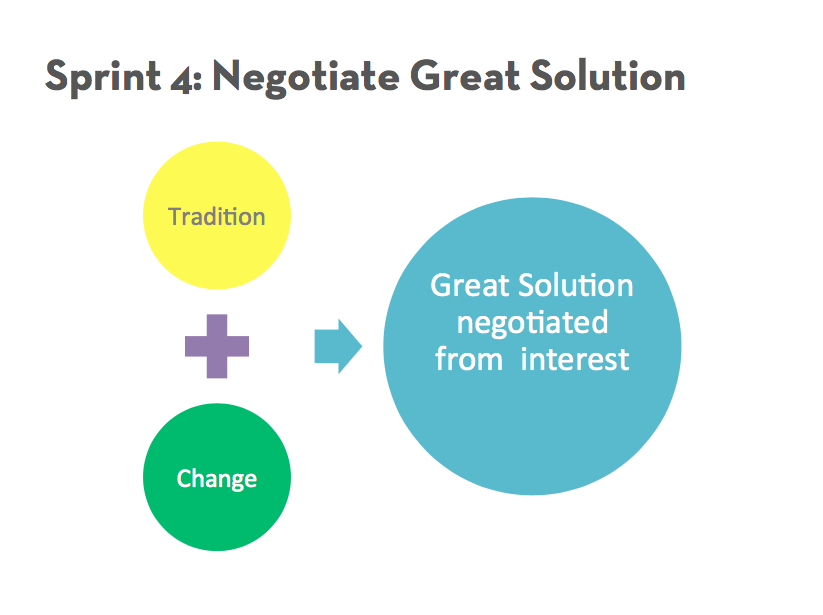4 Sprints and Spirits Method (4SSM)
Engineering curriculum change is mission impossible, or at least that’s what I thought last year when 3Joy was called by a client in South America and asked to help with a curriculum change project. I asked, how many years do you have to make the changes and they replied, “2 months.” Despite doubts about the likely success of the project, 3Joy agreed to help and designed what we now call the 4 Sprints and Spirits Method for Rapid Academic Change. Although the particular project was curriculum change, this process applies to all kinds of engineering education change (and higher ed change more generally).
Using modern agile development methods, design thinking, and a rigorous approach to soft skills (what 3Joy calls shift skills), transformative change can be brought about in weeks and months, not years or decades.
Why Change? The University-Zombie Apocalypse
The modern university was founded in 1088 in Bologna, Italy and since that time its operating system & principles of organization have remained fairly constant and been built on the principle of expertise, increasingly following a division of labor and ever specialized fields of study and knowledge. The problem with this model in our times is that the internet overturns conventional notions of authority and expertise, yet the university stands pat on its extant system of organization, titles, processes, and rituals. Both teaching and research authority are challenged by new online institutions. In this way the university has missed 3 revolutions:
- The quality revolution
- The entrepreneurial revolution
- The information technology (IT) revolution
Although universities teach about quality, entrepreneurship, and IT, they don’t practice them very effectively themselves, and increasingly the private sector and students themselves are looking elsewhere. Although governments keep these ancient institutions afloat, they are less vibrant than they were in the 50s and 60s, and at the continuation of universities in this way is what 3Joy calls the University-Zombie Apocalypse. Universities won’t go away, but they will be augmented or supplanted by other more vibrant institutions in better alignment with the 3 revolutions.
Six Failures of Traditional Curriculum Reform
Traditional curriculum reform takes a long time and generally fails to make substantive change fails because it is
- ego-driven arm wrestling;
- a kind of NIMBY problem;
- usually performed by committees without facilitation;
- mere shuffling and tweaking of course boxes;
- largely ignorant of innovation elsewhere;
- oblivious to major stakeholders, especially students.
The first two of these points are crucial. Curriculum committees are filled with big egos and the arguments are often something like, “the best curriculum is the one I took as an undergraduate.” This leads to a NIMBY = “not in my backyard” problem like the siting of a nuclear power plant, where people want the power but not the plant. The educational equivalent is, “Innovation is great, just don’t change my course.” These twin problems are exacerbated by poorly structured processes (items 3 and 4), a lack of awareness about the best practices elsewhere (item 5), and lack of involvement of employers and students.
4 Sprints and Spirits Method (4SSM)
In solving these problems in South America, the design team at 3Joy recognized that (1) curriculum reform fails for cause, (2) modern action frameworks (agile methods, design thinking, etc.) are widely used and effective (largely, outside the university), (3) universities think of practice as the mere application of well-vetted theory, and (4) practice is rooted in a rigorous set of soft, largely conversational, skills.
With this understanding the 4 Sprints Method (4SM) divides the change process into four periods of structured changes, the 4 sprints, as follows:
- Spirits of change sprint
- Invention & innovation sprint
- Conceptual canvases sprint
- Negotiating a solution sprint
During each of these sprints, the full change team is subdivided in four subteams–the 4 spirits of change–as follows:
- Student futures
- Motivation
- Culture
- Contraries
These subteams are continued throughout the 4 sprints, and in each sprint, each of the spirits teams make progress toward real, transformative change.
In the first sprint, the 4 spirits subteams study key ideas about their spirit and analyze the department/college from that perspective. In the second sprint, the subteams study best innovative practices at their school and elsewhere to come up with bright spots and great possibilities for change. In the third sprint, the teams create one or more conceptual canvases, broad outlines for change in the educational program, and discuss their areas of similarity and difference. In the final sprint, a solution is negotiated using key ideas from modern negotiation practice (negotiation from interests, not positions) with special attention paid to navigating the polarity between tradition and change.
Can the 4SSM Method Work for You?
The 4 Sprints and Spirits Method can help take a department, college, or school on a practical learning and conversation journey that leads to change appropriate to the unit’s culture in ways aligned with best practices at home and around the world. The method does not presuppose a particular solution, but instead relies on faculty members, students, and other stakeholders to drive the process toward helpful innovation in a relatively speedy way. The method does not eliminate controversy, but instead steps into it in ways that embrace both tradition and change, both, as well as other contraries (teaching/research, student-led & teacher-led learning, individual and teamwork, and so on).
To learn how the method can work for you contact Dave Goldberg at deg@threejoy.com.







